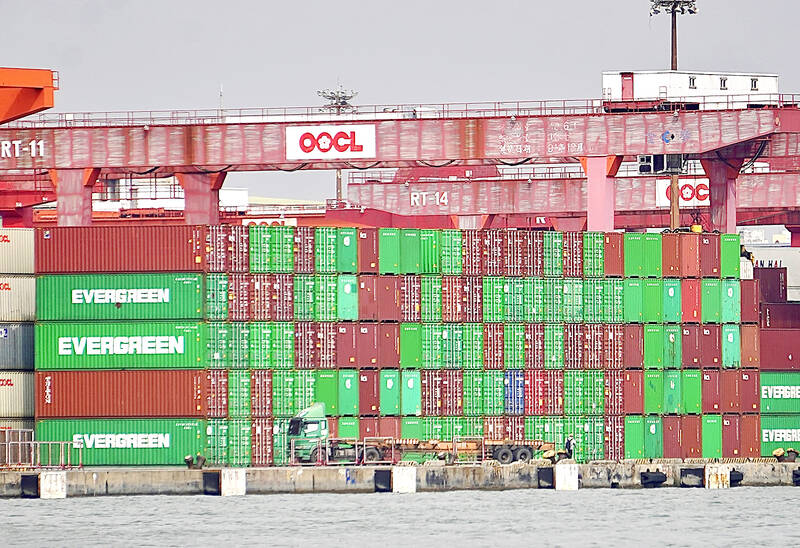Exports last month increased a modest 3.5 percent year-on-year to US$37.36 billion, as shipments of electronics used in artificial intelligence (AI) remained strong and some non-tech products came out of the woods, the Ministry of Finance said yesterday.
The increase lagged behind the 7 to 10 percent range the ministry expected, as firms at home and abroad largely maintained a cautious business approach, but their inventory mostly returned to healthy levels and the global economy is improving, Department of Statistics Director-General Beatrice Tsai (蔡美娜) said.
There is a lingering uneven recovery between product categories and export destinations — with exports of information and communication technology (ICT) products to the US driving most of the growth, helped by aggressive spending of US technology giants on AI infrastructure, she said.

Photo: CNA
The megatrend explained why ICT shipments such as AI servers and graphics cards surged 62.4 percent to US$9.42 billion, underpinning 25.2 percent of overall shipments, Tsai said.
Meanwhile, exports of electronics, mainly chips, shed 11 percent to US$13.4 billion, she said, adding that the retreat in electronics likely had to do with the reclassification of partial exports as imports to reflect changes in manufacturing locations.
It is better to combine electronics and ICT shipments to gain a better picture, as the two categories made up 64 percent of total exports and made a solid gain in the first five months of this year, she said.
Taiwan Semiconductor Manufacturing Co’s (TSMC, 台積電) robust revenue lent support to such an interpretation, Tsai said.
TSMC yesterday posted NT$229.62 billion (US$7.12 billion) of revenue for last month, a 30.2 percent spike from a year earlier.
Shipments of optical and precision products plunged 31.2 percent to US$892 million, while exports of transportation tools shrank 25 percent to US$880 million, the ministry’s report showed.
On the other hand, some non-tech products emerged from a slowdown, as customers started to rebuild inventory, Tsai said.
Exports of plastic grew 0.6 percent, while chemical and mineral products saw a growth 8.9 percent, the ministry said.
Shipments of textile products bounced 10.2 percent, given the demand for sportswear for the upcoming Olympic Games, she said.
Imports increased 0.6 percent to US$31.31 billion, giving Taiwan a trade surplus of US$6.05 billion, which is 21.6 percent higher than a year earlier, the ministry said.
Imports of agricultural and industrial raw materials picked up 5.8 percent, while imports of semiconductor equipment and luxury products declined 11.4 percent and 10.7 percent each, it said.
In the first five months, exports expanded 9.1 percent to US$185.14 billion and imports rose 3.2 percent to US$153.69 billion, it said.

CHIP RACE: Three years of overbroad export controls drove foreign competitors to pursue their own AI chips, and ‘cost US taxpayers billions of dollars,’ Nvidia said China has figured out the US strategy for allowing it to buy Nvidia Corp’s H200s and is rejecting the artificial intelligence (AI) chip in favor of domestically developed semiconductors, White House AI adviser David Sacks said, citing news reports. US President Donald Trump on Monday said that he would allow shipments of Nvidia’s H200 chips to China, part of an administration effort backed by Sacks to challenge Chinese tech champions such as Huawei Technologies Co (華為) by bringing US competition to their home market. On Friday, Sacks signaled that he was uncertain about whether that approach would work. “They’re rejecting our chips,” Sacks

Taiwan’s exports soared 56 percent year-on-year to an all-time high of US$64.05 billion last month, propelled by surging global demand for artificial intelligence (AI), high-performance computing and cloud service infrastructure, the Ministry of Finance said yesterday. Department of Statistics Director-General Beatrice Tsai (蔡美娜) called the figure an unexpected upside surprise, citing a wave of technology orders from overseas customers alongside the usual year-end shopping season for technology products. Growth is likely to remain strong this month, she said, projecting a 40 percent to 45 percent expansion on an annual basis. The outperformance could prompt the Directorate-General of Budget, Accounting and

BARRIERS: Gudeng’s chairman said it was unlikely that the US could replicate Taiwan’s science parks in Arizona, given its strict immigration policies and cultural differences Gudeng Precision Industrial Co (家登), which supplies wafer pods to the world’s major semiconductor firms, yesterday said it is in no rush to set up production in the US due to high costs. The company supplies its customers through a warehouse in Arizona jointly operated by TSS Holdings Ltd (德鑫控股), a joint holding of Gudeng and 17 Taiwanese firms in the semiconductor supply chain, including specialty plastic compounds producer Nytex Composites Co (耐特) and automated material handling system supplier Symtek Automation Asia Co (迅得). While the company has long been exploring the feasibility of setting up production in the US to address

OPTION: Uber said it could provide higher pay for batch trips, if incentives for batching is not removed entirely, as the latter would force it to pass on the costs to consumers Uber Technologies Inc yesterday warned that proposed restrictions on batching orders and minimum wages could prompt a NT$20 delivery fee increase in Taiwan, as lower efficiency would drive up costs. Uber CEO Dara Khosrowshahi made the remarks yesterday during his visit to Taiwan. He is on a multileg trip to the region, which includes stops in South Korea and Japan. His visit coincided the release last month of the Ministry of Labor’s draft bill on the delivery sector, which aims to safeguard delivery workers’ rights and improve their welfare. The ministry set the minimum pay for local food delivery drivers at